
Pietà is a small town in the Central Region of Malta, located near the outskirts of the capital city Valletta. Pietà is the suburb next-closest to the capital after Floriana. Its name is derived from Italian and signifies "Mercy."

Żejtun is a city in the South Eastern Region of Malta, with a population of 11,218 in the end of 2016. Żejtun is traditionally known as Città Beland, a title conferred by the grandmaster of the Order of the Knights of Malta, Ferdinand von Hompesch zu Bolheim in 1797. Before that, the village was known as Casale Santa Caterina, named after its patron saint and parish titular.

Qormi, also known by its title Città Pinto, is a city in the Southern Region of Malta, southwest of Valletta in the centre of the island. It has a population of 16,324, making it Malta's fifth-largest city.

Naxxar is a small city in the Northern Region of Malta, with a population of 14,891 people as of March 2014. The Naxxar Church is dedicated to Our Lady of Victories. The annual village feast is celebrated on 8 September. Naxxar was formerly known for hosting the Maltese International Trade Fair at Maltese International Trade Fair Grounds.

Santa Venera is a town in the Central Region of Malta, with a population of around 6,932. It is located between the towns of Birkirkara and Ħamrun, and it also borders Qormi and Msida.
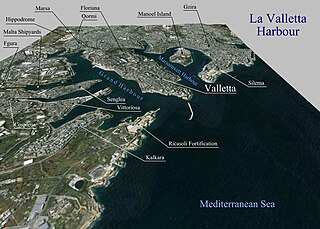
The Grand Harbour, also known as the Port of Valletta, is a natural harbour on the island of Malta. It has been substantially modified over the years with extensive docks, wharves, and fortifications.
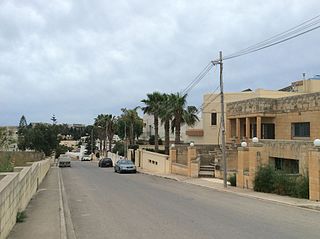
Iklin is a village in the Central Region of Malta, with a population of 3,247 as at 2021. Iklin was established in the mid-20th century; however some archaeological sites and a medieval chapel, named as St. Michael Chapel, are proof to earlier settlements. Until recently, the town was considered to form part of the Three villages of Malta, as part of Lija. With the separation of Iklin from Lija, Iklin is no longer part of the three villages. It is bordered by Għargħur, San Ġwann, Birkirkara, Balzan and Naxxar.

St Helen's Basilica is an 18th-century Roman Catholic church situated in Birkirkara, Malta. It is built on the baroque design by Salvu Borg and built by Mason Domenico Cachia. The design was inspired, and is similar, to the Mdina Cathedral by Lorenzo Gafa. It was built to replace the role of the main old Parish Church of St. Mary that was damaged in the 1856 earthquake. It eventually became the Collegiate Church and then a Minor Basilica. The current parish archpriest is Mons Louis Suban.

In Malta most of the main roads are in the outskirts of the localities to connect one urban area with another urban area. The most important roads are those that connect the south of the island with the northern part, like Tal-Barrani Road, Aldo Moro Street in Marsa and Birkirkara Bypass.
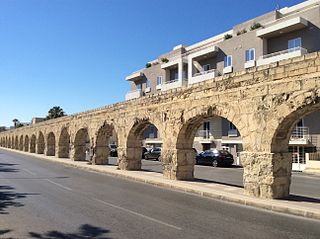
The Wignacourt Aqueduct is a 17th-century aqueduct in Malta, which was built by the Order of Saint John to carry water from springs in Dingli and Rabat to the newly built capital city Valletta. The aqueduct was carried through underground pipes and over arched viaducts across depressions in the ground.
The Kordin Temples are a group of megalithic temples on Corradino Heights in Paola, Malta. The temples were inhabited from pre-history, by Phoenicians and then by the Greeks and Roman periods. In the 17th century the site belonged to Giovanni Francesco Abela. He had excavated several sites in the whereabouts, and had his country residence in the area. He had originally planned to write his will to the Order, but eventually left his villa, that was used as Malta's first museum, known as Museo di San Giacomo, and the surrounding lands to the Jesuits. The land still belonged to the Jesuits, until their expulsion in the 18th century by the Order when all their land and property was taken by the treasury. The site was excavated during the Order of St. John on the order of Grand Master Manuel Pinto da Fonseca by archeologist Gio Antonio Barbaro. The temples were then extensively excavated by Sir Themistocles Zammit during the British period.

Villa Guardamangia, formerly known as Casa Medina and sometimes referred to as Casa Guardamangia, is a 16,791 square feet (1,559.9 m2) townhouse in Gwardamanġa, Pietà, Malta, which served as the residence of Princess Elizabeth, Duchess of Edinburgh, and Prince Philip, Duke of Edinburgh, between 1949 and 1951, while Philip was stationed in Malta as a naval officer.

Palazzo Parisio, sometimes known as Casa Parisio, is a palace in Valletta, Malta. It was built in the 1740s by Domenico Sceberras, and eventually passed into the hands of the Muscati and Parisio Muscati families. It was Napoleon's residence for six days in June 1798, during the early days of the French occupation of Malta. The palace was eventually acquired by the de Piro family, and was later purchased by the Government of Malta. It was used as the General Post Office from 1886 to 1973, then the Ministry for Agriculture, and it now houses the Ministry for Foreign Affairs.
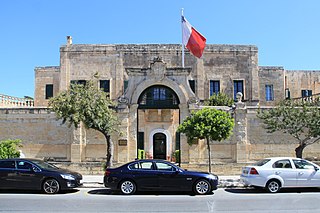
Casa Leoni or Casa Leone, also known as Palazzo Manoel or the Vilhena Palace, is a palace in Santa Venera, Malta, which was built as a summer residence for Grand Master António Manoel de Vilhena in 1730. It was subsequently used for a number of purposes, including as an insurgent command base, an official residence, a museum depository and a school. It currently houses the Ministry for Sustainable Development, the Environment and Climate Change.

Canon Giovanni Pietro Francesco Agius de Soldanis, often called de Soldanis, was a Maltese linguist, historian and cleric from the island of Gozo. He wrote the first lexicon and systematic grammar of the Maltese language, and he was the first librarian of the Bibliotheca Publica, the precursor of the National Library of Malta.

Maltese Baroque architecture is the form of Baroque architecture that developed in Malta during the 17th and 18th centuries, when the islands were under the rule of the Order of St. John. The Baroque style was introduced in Malta in the early 17th century, possibly by the Bolognese engineer Bontadino de Bontadini during the construction of the Wignacourt Aqueduct. The style became popular in the mid to late 17th century, and it reached its peak during the 18th century, when monumental Baroque structures such as Auberge de Castille were constructed.
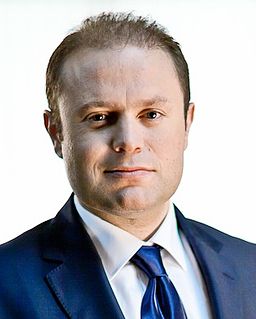
The 2019 European Parliament election was held in Malta on 25 May 2019. 8 different political parties took part in the election, of which, only 2 won seats in the European Parliament; the Labour Party and the Nationalist Party, with 4 and 2 seats respectively.



















